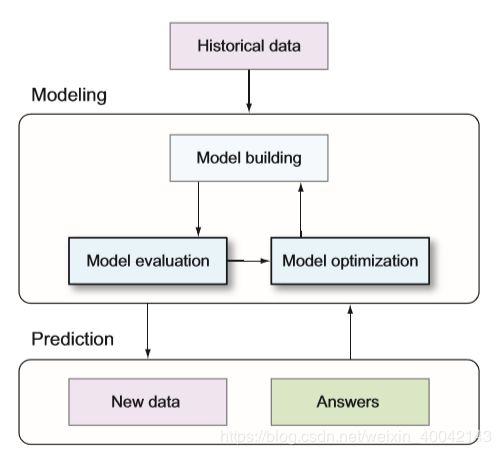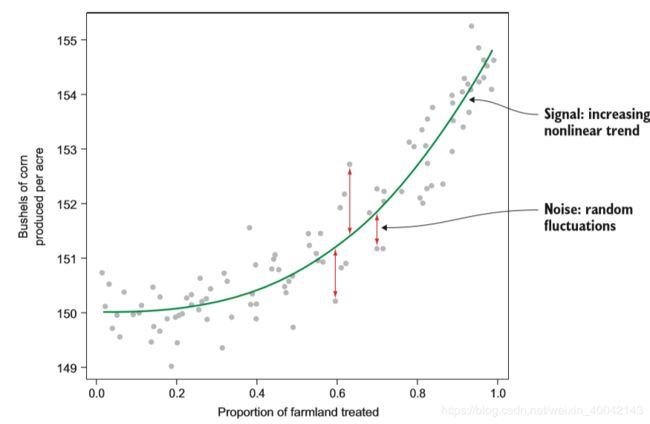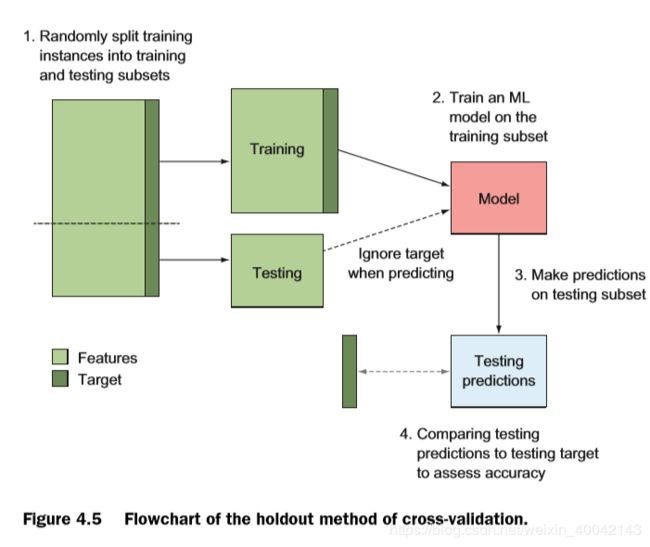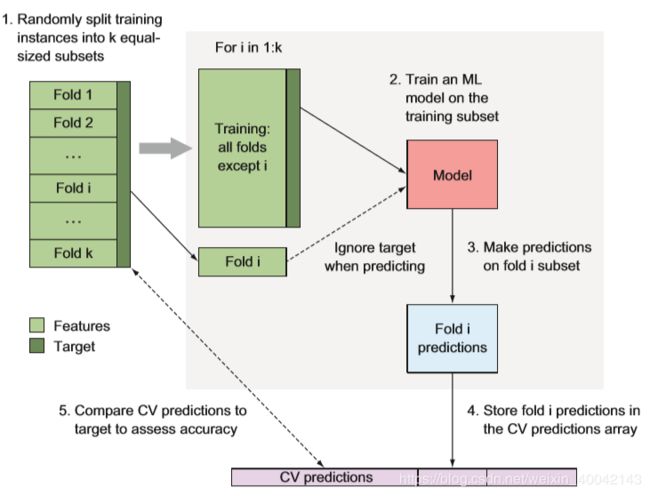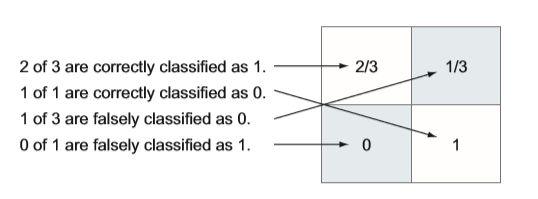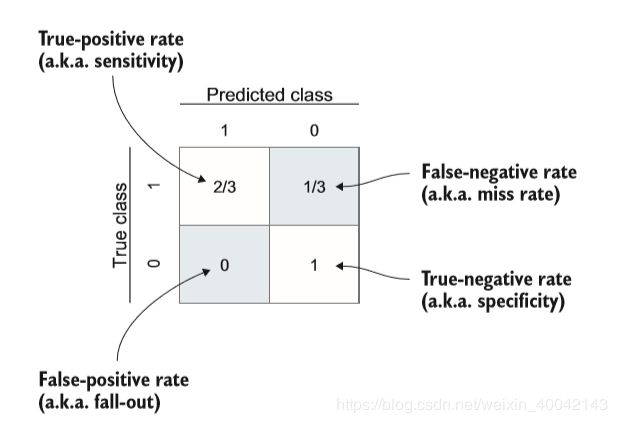机器学习:模型评估与优化
Real-World Machine Learning: Model Evaluation and Optimization
地址:https://livebook.manning.com/#!/book/real-world-machine-learning/chapter-4/9
本文主要是对书上的重要内容进行了提炼翻译笔记,供日后的学习。主要内容包括:
利用交叉验证来评估模型的预测性能
如何避免过拟合
对于二分类和多类别分类的评估指标和可视化
对于回归模型的评估指标和可视化
通过调参来优化模型
当你拟合好一个模型后,下一步需要评估这个模型的精确性。在使用模型之前,你应该要了解这个模型对于新的数据的预测能力如何。如果模型的预测性能很好,那么你可以将其用于生产环境中进行数据分析,否则,你需要对你的模型进行优化,提高其准确性。
对ML模型进行性能评估是一件很重要的事情,下面将通过图片和相关的代码给大家展示。
图一 ML工作流中的评估与优化
1.1通用模型:对新数据的预测的准确性评估
对于监督学习的主要目标:预测结果准确。你需要利用训练好的模型对新数据尽可能的预测准确,即模型对新数据的泛化性要好。这样,你的模型应用到生产中才会有好的结果。
1.1.1过拟合问题和模型优化
下面通过一个例子来进行理解:
假设要预测一个农场每亩玉米的产量。你可以通过100个农场的训练数据信息来解决这个回归问题。将每亩的产量和处理过的特征对应绘制如下图,根据图可以看出他们呈现增长性和非线性的关系。
选择一个模型进行训练,可能回出现如下的情况
第一个图:过拟合
第二个图:刚好
第三个图:欠拟合
为了避免过拟合或欠拟和的情况出现,第一步要做的时选择一个 评估指标来刻画的预测性能的好坏。对于回归问题,评估指标均方误差MSE:mean squared error,它是真实值和预测值之间测差值。
注意:不要使用训练模型的数据来评估模型
1.1.2交叉验证
问题:训练误差不能很好的指示出模型在新数据上的误差
解决:cross-validation交叉验证CV
常用的两个交叉验证的方法:holdout和k-fold
holdout方法:
将数据集划分成训练集和测试集,训练集用于模型的训练,测试集用于评估模型的准确性。下图展示了holdout方法的一个使用流程。
使用scikit-learn上面关于模型选择的 模块进行holdout方法的实验
import numpy as np
from sklearn.model_selection import train_test_split
from sklearn.metrics import mean_squared_error
from sklearn import datasets
from sklearn import svm
iris = datasets.load_iris()
print(iris.data.shape)
print(iris.target.shape)
# 划分数据集
X_train, X_test, y_train, y_test = train_test_split(iris.data, iris.target, test_size=0.3, random_state=0)
# 训练模型
clf = svm.SVC(kernel='linear', C=1).fit(X_train, y_train)
# 预测
pred_y = clf.predict(X_test)
# 计算MSE
mse = mean_squared_error(y_test, pred_y)
print(mse)
k-fold方法:
将数据集划分成k个大小相等的互斥子集,每个子集都尽可能的保持一样的数据分布:从数据集中通过分层采样获得。
每次用k-1个子集的并集作为训练集,剩下的那个子集作为测试集--k组训练/测试集。
使用scikit-learn上的模块演示
import numpy as np
from sklearn.model_selection import train_test_split, KFold
from sklearn.metrics import mean_squared_error
from sklearn import datasets
from sklearn import svm
iris = datasets.load_iris()
print(iris.data.shape)
print(iris.target.shape)
mse_arr = []
kf = KFold(n_splits=10)
for train_index, test_index in kf.split(iris.data):
print("train_index", train_index, "test_index", test_index)
# 训练模型
clf = svm.SVC(kernel='linear', C=1).fit(iris.data[train_index], iris.target[train_index])
# 预测
pred_y = clf.predict(iris.data[test_index])
# 计算MSE
mse = mean_squared_error(iris.target[test_index], pred_y)
mse_arr.append(mse)
print(mse_arr)
使用cross0validation方法时需要注意一下几个问题:
- 划分后的数据集样本分布尽可能一致
- 对于具有时序特征的数据,比如用上个月的收入数据预测这个月的收入数据,在这种情况下,不能出现用未来的数据预测过去的数据的情况
- k值越大,误差估计越好,但是运行时间长----k>=10
分类模型的评估
对于二分类问题,测试集标签和预测结果如下图:
可以看出,有75%的预测结果和真实值一样
分类结果混淆矩阵
1.2.2 ROC曲线---可视化工具
对于有一类ML,它的输出是一个实值或者概率,然后将这个预测值和分类阈值进行比较来判别样本的类别。
---概率分类器
ROC曲线通过计算混淆矩阵获得的
二分类ROC曲线(scikit-learn上的例子)
import numpy as np
from scipy import interp
import matplotlib.pyplot as plt
from sklearn import svm, datasets
from sklearn.metrics import roc_curve, auc
from sklearn.model_selection import StratifiedKFold
iris = datasets.load_iris()
features = iris.data
target = iris.target
features, target = features[target != 2], target[target != 2]
n_samples, n_features = features.shape
ramdom_state = np.random.RandomState(0)
features = np.c_[features, ramdom_state.randn(n_samples, 200 * n_features)]
# 分类
cv = StratifiedKFold(n_splits=10)
classifier = svm.SVC(kernel='linear', probability=True, random_state=ramdom_state)
tprs = []
aucs = []
mean_fpr = np.linspace(0, 1, 100)
i = 0
for train, test in cv.split(features, target):
probas = classifier.fit(features[train], target[train]).predict_proba(features[test])
# 计算ROC
"""
roc_curve
参数:
y_true:真实值标签(test的标签)
y_score:预测值概率
返回值:
fpr:false positive rates
tpr:true positive rates
threshold
"""
fpr, tpr, threshold = roc_curve(target[test], probas[:, 1])
tprs.append(interp(mean_fpr, fpr, tpr))
tprs[-1][0] = 0.0
"""
auc
参数:
x:fpr,横坐标
y:tpr,纵坐标
return:
auc:float
"""
roc_auc = auc(fpr, tpr)
aucs.append(roc_auc)
plt.plot(fpr, tpr, lw=1, alpha=0.3,
label='ROC fold %d (AUC = %0.2f)' % (i, roc_auc))
i += 1
plt.plot([0, 1], [0, 1], linestyle='--', lw=2, color='r',
label='Chance', alpha=.8)
mean_tpr = np.mean(tprs, axis=0)
mean_tpr[-1] = 1.0
mean_auc = auc(mean_fpr, mean_tpr)
std_auc = np.std(aucs)
plt.plot(mean_fpr, mean_tpr, color='b',
label=r'Mean ROC (AUC = %0.2f $\pm$ %0.2f)' % (mean_auc, std_auc),
lw=2, alpha=.8)
std_tpr = np.std(tprs, axis=0)
tprs_upper = np.minimum(mean_tpr + std_tpr, 1)
tprs_lower = np.maximum(mean_tpr - std_tpr, 0)
plt.fill_between(mean_fpr, tprs_lower, tprs_upper, color='grey', alpha=.2,
label=r'$\pm$ 1 std. dev.')
plt.xlim([-0.05, 1.05])
plt.ylim([-0.05, 1.05])
plt.xlabel('False Positive Rate')
plt.ylabel('True Positive Rate')
plt.title('Receiver operating characteristic example')
plt.legend(loc="lower right")
plt.show()
多类别分类ROC曲线(scikit-learn上的例子)
# 多分类里ROC曲线
import numpy as np
import matplotlib.pyplot as plt
from itertools import cycle
from sklearn import svm, datasets
from sklearn.metrics import roc_curve, auc
from sklearn.model_selection import train_test_split
from sklearn.preprocessing import label_binarize
from sklearn.multiclass import OneVsRestClassifier
from scipy import interp
# Import some data to play with
iris = datasets.load_iris()
X = iris.data
y = iris.target
# Binarize the output
y = label_binarize(y, classes=[0, 1, 2])
n_classes = y.shape[1]
# Add noisy features to make the problem harder
random_state = np.random.RandomState(0)
n_samples, n_features = X.shape
X = np.c_[X, random_state.randn(n_samples, 200 * n_features)]
# 划分训练集和测试集---自定义划分
X_train, X_test, y_train, y_test = train_test_split(X, y, test_size=0.5, random_state=0)
# 利用1:rest策略处理多类别分类任务
classifier = OneVsRestClassifier(svm.SVC(kernel='linear', probability=True, random_state=random_state))
"""
fit:根据训练数据集拟合model
decision_function:计算出决策函数,返回每个类别样本的决策函数
predict(X):预测X类别
score(test_data测试数据,pre_y预测的标签):mean accuracy
"""
y_score = classifier.fit(X_train, y_train).decision_function(X_test)
# 计算ROC
# Compute ROC curve and ROC area for each class
fpr = dict()
tpr = dict()
roc_auc = dict()
for i in range(n_classes):
fpr[i], tpr[i], _ = roc_curve(y_test[:, i], y_score[:, i])
roc_auc[i] = auc(fpr[i], tpr[i])
fpr["micro"], tpr["micro"], _ = roc_curve(y_test.ravel(), y_score.ravel())
roc_auc["mixro"] = auc(fpr["micro"], tpr["micro"])
plt.figure()
lw = 2
plt.plot(fpr[2], tpr[2], color='darkorange', lw=lw, label="ROC cure (area=%0.2f)" % roc_auc[2])
plt.plot([0, 1], [0, 1], color='navy', lw=lw, linestyle='--')
plt.xlim([0.0, 1.0])
plt.ylim([0.0, 1.05])
plt.xlabel('False Positive Rate')
plt.ylabel('True Positive Rate')
plt.title('Receiver operating characteristic example')
plt.legend(loc="lower right")
plt.show()
1.3回归模型的评估
使用交叉验证来评估
对于回归模型来说,回归模型不能通过简单的正确性来评判。一个数值的预测通常情况下不是恰好正确的,它可能回接近或者和正确值相差很大,我们要通过预测值和真实值之间的误差来评估回归模型。
回归模型最简单的一个评估指标:MSE the root mean-square-error和the R-squared value.
MSE:预测值和真实值之间的误差平方和的均值
注意如果实际数据集本身就是很大的数值,那么MSE的计算值可能会很大,这个时候对于模型的评估就没那么好了
所以在计算的时候,可以先将数值型的数据集进行归一化处理,把数值缩小到【0~1】范围内
在使用MSE,RMSE进行回归模型的评估时需要注意:(不怎么理解原文)
1.4通过调参来优化模型
1.4.1常见的ML算法和其参数
logistic regression:None
KNN:K,近邻数
Decision Tree:划分指标spliting criterion,树的深度max depth pf tree,划分样本的最小数量minimum samples needed to make a split
Kernel SVM:核函数,核函数的系数,惩罚系数
随机森林:树的数量,每个叶子结点划分特征的数量,划分指标,划分样本的最小数量
Boosting:树的数量,学习率(学习器的权重系数),树的深度,划分指标,划分样本的最小数量
1.4.2grid search
暴力网格搜索;brute-force grid search
将交叉验证和模型评估联系起来
- 选择评估指标(AUC:分类,MSR or R^2:回归)
- 选择算法模型
- 选择要优化的参数以及对应的值放在数组里
- 将网格定义为参数数组的笛卡儿积
- 对每个网格里的值,通过交叉验证计算评估指标和预测值
- 选择评估指标最好的那个模型
scikit-learn上关于网格搜索优化模型的列子
from sklearn import datasets
from sklearn.model_selection import train_test_split
from sklearn.model_selection import GridSearchCV
from sklearn.metrics import classification_report
from sklearn.svm import SVC
print(__doc__)
# Loading the Digits dataset
digits = datasets.load_digits()
# To apply an classifier on this data, we need to flatten the image, to
# turn the data in a (samples, feature) matrix:
n_samples = len(digits.images)
X = digits.images.reshape((n_samples, -1))
y = digits.target
# Split the dataset in two equal parts
X_train, X_test, y_train, y_test = train_test_split(
X, y, test_size=0.5, random_state=0)
# Set the parameters by cross-validation
tuned_parameters = [{'kernel': ['rbf'], 'gamma': [1e-3, 1e-4],
'C': [1, 10, 100, 1000]},
{'kernel': ['linear'], 'C': [1, 10, 100, 1000]}]
scores = ['precision', 'recall']
"""
GridSearchVC
参数:
estimator:学习器
param_grid:一个列表,元素是字典类型的,学习器的参数名为key,参数值为value.
scoring:评估指标
cv:使用交叉验证,k
model的属性:
best_estimator:
best_param:
"""
for score in scores:
print("# Tuning hyper-parameters for %s" % score)
print()
clf = GridSearchCV(SVC(), tuned_parameters, cv=5,
scoring='%s_macro' % score)
clf.fit(X_train, y_train)
print("Best parameters set found on development set:")
print()
print(clf.best_params_)
print()
print("Grid scores on development set:")
print()
means = clf.cv_results_['mean_test_score']
stds = clf.cv_results_['std_test_score']
for mean, std, params in zip(means, stds, clf.cv_results_['params']):
print("%0.3f (+/-%0.03f) for %r"
% (mean, std * 2, params))
print()
print("Detailed classification report:")
print()
print("The model is trained on the full development set.")
print("The scores are computed on the full evaluation set.")
print()
y_true, y_pred = y_test, clf.predict(X_test)
print(classification_report(y_true, y_pred))
print()
